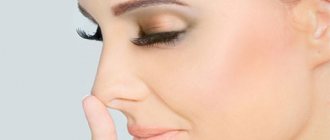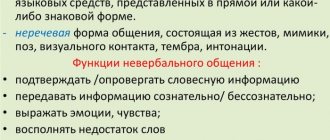Non-verbal communication. Truth or myth?
Some doubt the existence of body language, considering all conversations on this topic to be empty fiction.
Opponents of the theory of postures and gestures argue that changes in body position occur for completely different reasons. For example, when sitting, it is more convenient for a person to cross his arms if there are no armrests, and not at all because he is a misanthrope.
People start yawning not only because they start to get bored. Lack of oxygen in a cramped office or overwork can trigger this process. Therefore, before formulating conclusions, it is necessary to understand why the interlocutor began to actively gesticulate or rotate an object in his hands.
An experiment will help reveal sign language. And the subjects can be friends and relatives, whose facial expressions, postures and gestures change in different life situations. But in no case should you impose and put pressure, otherwise you can damage many years of friendship and good relationships.
Features of facial expressions
His facial expressions can say a lot about a person and his mood. Nonverbal gestures reflected on the face may indicate the following:
- narrowed eyes and pursed lips indicate an angry mood;
- raised eyebrows and wide open eyes mean surprise;
- in a state of fear, the lips are stretched wide and their corners are drawn down;
- happiness is characterized by a calm gaze and slightly raised corners of the mouth;
- a sad man brings his eyebrows together and lowers the corners of his lips.
Nonverbal Communication
Nonverbal communication is the process of transmitting thoughts without the use of speech - the second signaling system. It absorbs 60–80% of veiled information.
Each of us, when communicating with an opponent who competently sets out the essence of the matter and argues with facts, often feels some kind of catch in his words. But, despite the reliability and veracity of the information, intuition suggests that you should not rely entirely on this person. And with further communication, discomfort is felt, the person is looking for something to complain about.
And, indeed, the interlocutor is betrayed by changes in facial expressions, posture and gestures that contradict his smooth presentation. A certain inconsistency appears and serious concerns arise that he is not acting in your interests at all.
The ability to correctly read the secret language of gestures will help you avoid unpleasant situations. For example, HR specialists cannot do without knowledge about the hidden intentions of potential employees.
It is difficult for a person to hold back emotions for a long time; they must find a way out. But due to circumstances, rules of decency and norms of society, we are not free to surrender to the will of feelings and express them by changing posture, facial expressions and gestures. Often this behavior becomes the norm and turns into a habit.
Lack of interest
Sometimes a person continues the story, not suspecting that the interlocutor is absolutely not interested in it. Nonverbal communication will come to the rescue. Gestures indicating indifference are:
- If your interlocutor crosses his arms over his chest, he instinctively closes himself off from you. You are either indifferent to him or unpleasant.
- Pay attention to where the other person's gaze is directed. If he looks anywhere but in your direction, then you should end the conversation.
- If a person wants to end the conversation and leave, constantly looking at his watch will give him away. Also, the toes of his shoes may be pointed towards the door.
Examples of nonverbal communication
- If a girl, showing off her wrist, communicates with a member of the opposite sex, she lets him know that she is ready to get closer to him. And if he also paints his lips with bright lipstick, then he has truly become the object of her passion.
Read more: How to know that a girl likes you - 14 signs
- There is a common method of establishing contact with new acquaintances: you should copy his gestures and postures. If the interlocutor crossed his arms, you can repeat this body movement. This manipulation promotes non-verbal unity. There is a whole set of such small tricks.
To grasp the true meaning, you need to pay close attention to the position of the interlocutor's hands and feet.
Mainly gestures and postures emphasize the truth, and sometimes contradict what was said.
It is difficult to believe a person with crossed limbs convincing another of good intentions. It is unlikely that he will fulfill his promise. Surely he uses the location and trust of his partners for his personal interests.
Through gestures and posture you can hide some information from your opponents. Despite the casualness and ease of communication, the posture makes it clear that the owner does not intend to share important information with anyone.
Learn to recognize lies
In order to feel confident and comfortable in a situation of communicating with different people, to avoid manipulation, you should learn to recognize non-verbal language of communication in situations where they are trying to deceive you.
What means of nonverbal communication, gestures, postures, and facial expressions should you pay attention to in order to recognize a lie?
- excessively long or frequent pauses, pauses and hesitations before starting a line;
- asymmetry of facial expressions, lack of synchrony in the work of facial muscles, when there is a discrepancy in the facial expressions of the two sides of the face;
- a “frozen” facial expression, when it does not change for 5-10 seconds, is false;
- delayed expression of emotions, when long pauses arise between the word and the emotions associated with it;
- a “long” smile, where the lips are pulled back from the teeth, creating a narrow lip line;
- visual contact is shallow, when the liar's eyes meet the interlocutor's eyes for no more than a third of the entire conversation, while often looking at the ceiling and around with a restless expression on his face;
- twitching of any part of the body: tapping fingers on the table, biting the lip, twitching of arms or legs;
- scanty gestures that the liar keeps under control;
- high pitched voice, heavy breathing;
- bent body, crossed-legged poses;
- poor facial expressions, weak work of the facial muscles;
- quickly moving the eyes first to the upper right corner, and then to the lower left;
- quick, imperceptible at first glance, touching the nose, rubbing the eyelid;
- brighter gestures with the right hand compared to the left;
- any exaggeration: unnecessary movements and gestures, inappropriate emotions;
- frequent eye blinking
Knowing all the subtleties of non-verbal communication techniques, you will not only be able to avoid manipulation, but you yourself can easily learn how to manage people
Psychology of Gestures
Alan Pease, a famous psychologist, is called "Mr. Body Language." The author has published his works in millions of copies. Alana Pease set out to not only teach the reader to “decipher” body language, but also to apply the acquired knowledge in practice. Even the slightest changes do not escape his attention, up to the dilation of the pupils and the closing of the eyelids.
The author, analyzing the smallest details, identifies 2 important priorities.
Firstly, there is an opportunity to establish communications.
Secondly, it is possible with a high degree of probability to calculate a person’s further actions.
From the standpoint of psychological knowledge, Alan focuses on the distinctive features of behavior and gestures in women and men.
In addition to gender differences, the body movements of managers and subordinates differ sharply. Watching a conversation, you can record the rapid change of emotions.
NLP Resources
Emphasizing a certain connection between the internal, psychological content of the personality and the external, morphological features of the facial structure, it should be remembered that the face of any person is not something frozen, but represents a whole range of different movements, which is expressed in facial expressions.
For example, a fully raised head indicates self-confidence, strong self-awareness, complete openness and attention to the world around you due to an intense relationship with it. A pointedly raised head reveals a lack of intimacy, self-aggrandizement or arrogance. Throwing your head back demonstrates a great desire for activity, a challenge. And, on the contrary, a head tilted to one side indicates a refusal of one’s own activity, complete openness to the interlocutor “the desire to meet halfway, even to the point of submission. A relaxed head hanging down is a sign of a general lack of readiness for tension, lack of will.
The “language of gaze” is very diverse. Thus, completely open eyes characterize high receptivity of feelings and reason, general liveliness. Eyes that are too wide open/"bulging"/ indicate an increase in optical attachment to the surrounding world. Closed, “curtained” eyes are often a sign of inertia, indifference, arrogance, boredom or extreme fatigue. A narrowed or squinted gaze means either concentrated close attention /observation/, or /in combination with a side glance/ cunning, cunning. A direct gaze, with the face completely turned to the partner, demonstrates interest, trust, openness, and readiness for direct interaction. A sideways glance, from the corners of the eyes, indicates a lack of full dedication, skepticism, and mistrust. A look from below (with a bowed head) indicates either an aggressive readiness for action, or (with a bent back) subordination, humility, and helpfulness. Looking from top to bottom / with the head thrown back / reveals a feeling of superiority, arrogance, contempt, and the search for dominance. An evasive gaze indicates uncertainty, modesty or timidity, and possibly a feeling of guilt.
The corners of the mouth drawn down symbolize a generally negative attitude towards life, a general sad expression on the face. Raised corners of the mouth reflect a positive attitude towards life, a lively and cheerful expression. If the mouth appears plump, it indicates increased vitality of the senses; soft - for sensitivity; sharp, precisely carved - for intelligence; firm - for certainty of will.
The German anthropologist Carsten Nimitz, using a video recorder to study the dynamics of a smile, found that the impression of sincerity or feignedness of a smile arises depending on the speed with which the corners of the mouth rise, and on the simultaneous widening of the eyes, followed by a brief shift of the eyelids. The researcher emphasizes that widening the eyes for too long without briefly closing them in combination with a smile is considered a threat. On the contrary, briefly closing the eyes is a pacifying element of facial expression. The smiling one makes it clear: “I don’t expect anything bad from you, you see, I even close my eyes.” The means of nonverbal communication include, in addition to facial expressions and gestures. “Reading” hand language and gestures in general is increasingly becoming the subject of research, especially abroad /for example, G. Calero, D. Nyurenberg, A. Stangl, S. Dunkell, etc./.
A. Stangl in his works describes many gestures, especially the arms and hands, the “reading” of which allows you to better understand your interlocutor. Arms hanging sluggishly along the body - passivity, lack of readiness for action, lack of will.
Arms crossed on the chest is a defensive reaction, a certain isolation, “some waiting. Hands clasped behind the back - lack of readiness for action, as well as hidden carrying, timidity, predicament. palm open upward - a gesture of explanation, persuasion, open representation, giving. One or both hands are hidden in pockets - hiding difficulties, uncertainty, loss of spontaneity. The hand clenches into a fist - concentration, mastery of excitement, desire for self-affirmation. Rubbing hands - a person is possessed by pleasant, satisfying thoughts.
The hand takes something or makes a movement in a certain direction - directly bodily, material grasping, which is a sign of a greedy person who thinks too much about material possessions.
Movements of the hands that cover the face or part of it - the desire to hide, conceal, conceal one’s condition; thoughtfulness or difficulty. Erasing movement of hands on the forehead - erasing bad thoughts, bad ideas or concentrating on thoughts.
An open palm strokes something pleasant to the touch (for example, the other hand) - a gentle disposition, a complacent mood.
A tensely straightened index finger is a sign of concentration on the internal state, regardless of other people. The index finger, straight, touches the edge of the lips - a feeling of uncertainty, a search for reasons, help.
Finger stuck in mouth - naivety, state of absent-mindedness, misunderstanding.
A finger touching the eyes or ears is a sign of some awkwardness, a certain timidity, a desire to run away.
The tips of the index and thumb touch, while the rest, especially the little finger, protrude - a high degree of concentration of attention to the finest details.
Hands rest on the hips - the need to strengthen the self, strengthen it, demonstrate one’s firmness and superiority, challenge, bravado - from naive to malicious forms. Often overcompensation for hidden feelings of weakness or embarrassment.
Hands support the upper body, leaning on something /for example, on a table, the back of a chair, a low platform, etc./ - a desire for spiritual support or internal uncertainty.
Every human gesture is like a word in a language. By reading gestures, we provide feedback that plays a major role in the interaction process, and test groups are an important component of feedback.
“Wordless” feedback can warn you that you need to change your behavior or do something to achieve the result you want in communicating with your students or about a specific interlocutor.
Here are some groups of gestures described by American communication specialists D. Nyurenberg and G. Calero.
Gestures of openness. Among them, the following can be distinguished: open hands with palms up / a gesture associated with sincerity and openness /, a shrug accompanied by a gesture of open hands / indicates openness of nature/, unbuttoning a jacket / people who are open and friendly towards you often unbutton their jacket during a conversation and even take it off in your presence/. For example, when children are proud of their achievements, they openly show their hands, and when they feel guilty or wary, they hide their hands either in their pockets or behind their backs. Experts also noticed that during successful negotiations, their participants unbutton their jackets, straighten their legs, and move to the edge of the chair close to the table, which separates them from the interlocutor.
Gestures of protection /defensive/. They respond to possible threats and conflict situations. When we see that the interlocutor has his arms crossed on his chest, we should reconsider what we are doing or saying, because he begins to move away from the discussion. Hands clenched into fists also mean a defensive reaction from the speaker.
Gestures of appreciation. They express thoughtfulness and dreaminess. For example, the hand-to-cheek gesture—people resting their cheek on their hand are usually deep in thought. A gesture of critical assessment - the chin rests on the palm. the index finger is extended along the cheek, the remaining fingers are below the mouth / “wait and see” position/. A person sits on the edge of a chair, elbows on hips, arms hanging freely / “this is wonderful!” position. A bowed head is a gesture of attentive listening. So, if the majority of listeners in the audience do not have their heads bowed, it means that the group as a whole is not interested in the material that the teacher is presenting. Scratching the chin / "okay, let's think about it" gesture / is used when a person is busy making a decision. Gestures about glasses / wipes glasses, puts the frame of glasses in the mouth, etc. / - this is a pause for reflection. reflecting on one's situation before more vigorously resisting, asking for clarification or raising a question.
Pacing is a gesture that indicates an attempt to resolve a difficult problem or make a difficult decision. Pinching the bridge of the nose is a gesture, usually combined with closed eyes, and indicates deep concentration of intense thought.
Gestures of boredom. They are expressed by tapping your foot on the floor or clicking the cap of a pen. Head in the palm of your hand. Automatic drawing on paper. Empty look / “I look at you, but I don’t listen”/.
Gestures of courtship, “preening.” For women, they look like smoothing their hair, straightening their hair, clothes, looking at themselves in the mirror and turning in front of it; swaying your hips, slowly crossing and spreading your legs in front of a man, stroking yourself on your calves, knees, thighs; balancing shoes on the tips of the fingers / “in your presence I feel comfortable” /, for men - adjusting a tie, cufflinks, jacket, straightening the whole body, moving the chin up and down, etc.
Gestures of suspicion and secrecy. The hand covers the mouth - the interlocutor carefully hides his position on the issue under discussion. Looking to the side is an indicator of secrecy. Feet or the whole body facing the exit is a sure sign that a person wants to end a conversation or meeting. Touching or rubbing the nose with the index finger is a sign of doubt / other varieties of this gesture are rubbing the index finger behind the ear or in front of the ear, rubbing the eyes /
Gestures of dominance and submission. Superiority can be expressed in a welcoming handshake. When a person shakes your hand firmly and turns it so that his palm rests on top of yours, he is trying to express something like physical superiority. And, conversely, when he extends his hand with his palm up, it means he is ready to accept a subordinate role. When the interlocutor’s hand is casually tucked into his jacket pocket during a conversation, and his thumb is outside, this expresses the person’s confidence in his superiority.
Gestures of readiness. Hands on hips are the first sign of readiness (this can often be observed in athletes waiting for their turn to perform). A variation of this pose in a sitting position - a person sits on the edge of a chair, the elbow of one hand and the palm of the other resting on the knees / this is how they sit immediately before concluding an agreement or. on the contrary, before getting up and leaving/.
Gestures of reinsurance. Different finger movements reflect different sensations: uncertainty, internal conflict, fears. In this case, the child sucks his finger, the teenager bites his nails, and the adult often replaces his finger with a fountain pen or pencil and bites them. Other gestures of this group are interlocking fingers, with the thumbs rubbing each other; pinching of the skin; touching the back of a chair before sitting down in a gathering of other people.
For women, a typical gesture of instilling inner confidence is a slow and graceful raising of the hand to the neck.
Gestures of frustration. They are characterized by short, intermittent breathing, often accompanied by unclear sounds such as moaning, mooing, etc. / one who does not notice the moment when his opponent begins to breathe quickly and continues to prove his point may run into trouble /; tightly entwined, tense hands - a gesture of distrust and suspicion / one who tries, by clasping his hands, to assure others of his sincerity, usually does not succeed /, the hands are closely clasped together - this means the person is in a “trouble” / for example, must respond to question. containing a serious accusation against him/; stroking the neck with the palm of the hand /in many cases when a person is defending himself/ - women usually adjust their hair in these situations.
Gestures of trust. The fingers are connected like the dome of a temple / “dome” gesture/, which means trust and some self-satisfaction, selfishness or pride / a very common gesture in boss-subordinate relationships/.
Gestures of authoritarianism. The hands are connected behind the back, the chin is raised (this is how army commanders, police officers, and senior leaders often stand). In general, if you want to make your superiority clear, you just need to physically rise above your opponent - sit above him if you are talking while sitting, or maybe stand in front of him.
Gestures of nervousness. Coughing, clearing the throat /those who often do this feel insecure, anxious/, elbows are placed on the table, forming a pyramid, the top of which is the hands located directly in front of the mouth / such people play “cat and mouse” with partners while they do not give them the opportunity to “reveal their cards,” which is indicated by moving their hands away from their mouths onto the table, jingling coins in their pockets, indicating concern about the availability or lack of money; tugging at one's ear is a sign that the interlocutor wants to interrupt the conversation, but is restraining himself.
Gestures of self-control. Hands placed behind the back and tightly clenched. Another pose is when a person sits in a chair with his ankles crossed and his hands gripping the armrests (typical of waiting for an appointment with the dentist). Gestures of this group signal a desire to cope with STRONG FEELINGS AND EMOTIONS /16/.
General and specific characteristics of a person’s posture and gait can also tell a lot to the attentive observer. Good, relaxed posture indicates high receptivity and openness, the ability to immediately use internal forces and freedom from any limitation. Stiffness or tension in the body indicates a self-protective reaction, avoidance of contact, closedness, often sensitivity, as well as an awkward attempt to be correct. Poor, sluggish posture, stooped back, reveal submissiveness, humility, servility. Postures of the conventional kind (one or two hands in pockets, hands behind the back or crossed on the chest, etc.) indicate a lack of independence and a need to quietly include oneself in the general order.
The upper part of the human body is very informative. For example, high shoulders with a slightly hunched back and retracted chin “speak” of helplessness, nervousness, chronic fear, uncertainty and timidity; shoulders falling forward indicate a feeling of weakness and depression, an inferiority complex.
The free lowering of the shoulders indicates an emerging feeling of confidence, inner freedom, and mastery of the situation. Pulling your shoulders back means determination to act, a sense of strength, activity, enterprise, and often an overestimation of your own capabilities.
A protruding chest is observed in active people, with a developed sense of self-worth and a need for social contacts; a sunken chest often indicates a certain indifference, isolation, passivity, humility and depression.
The position of the legs and feet can also provide certain information about the state and psychological qualities of a person. Thus, a person standing confidently on his feet (legs spaced no more than two palm widths apart), with an even distribution of body weight, indicates that this is a strong “balanced” person , calm, strong character, able to adapt to circumstances. A motionless, frozen posture, under strong tension, indicates poor adaptability, stubbornness, and inflexible self-affirmation.
A variable standing posture, with a lack of tension, and frequent changes of the supporting leg and position of the feet, reveals a lack of firmness and discipline, unreliability and timidity. Rocking on your toes means either preparation for active movement, or an aggressive attitude, or indicates arrogance. The “legs wide apart” stance indicates the need for self-affirmation, broad claims, inflated self-esteem and often a feeling of inferiority.
If the gait or stance is characterized by a noticeable turn of the toes outward, then this speaks of a “swaggering gait”, conceit and complacency / “stands as a peahen”/. If the toes are turned inward, then this indicates a certain internal weakness, a relative lack of tension, and doubt in one’s abilities.
There are several types of gait:
- rhythmic - a relaxed form of an elevated but balanced mood) is typical for walkers;
- uniform / like an army marching step / - volitional activity or striving for a goal;
- big steps - often extroversion, determination, enterprise, ease, abstract thinking;
- short, small steps - often introversion, careful calculation, quick thinking and reaction, restraint, type of thinking, rather concrete;
- rhythmically strong / with increased movements of the hips / - naive-instinctive and self-confident natures, swaying shoulders | in resonance - mainly showy, narcissistic individuals;
- shuffling, “sagging” - refusal of volitional efforts and aspirations, lethargy, slowness, laziness;
- hard, angular, “stilted”, “wooden” - tightness, lack of contacts, timidity, inability to express themselves freely.
- constant lifting on tense toes - upward striving, driven by a strong need for a feeling of superiority, especially intellectual.
There are several different ways to seat a person:
- closed / legs and feet closed / - fear of contact, lack of self-confidence;
- carefree-open / legs or hips widely spaced / - lack of discipline, laziness, indifferent-primitive unceremoniousness;
- legs closed one behind the other - natural self-confidence, complacent mood, no readiness for activity or defense;
- sitting on the edge of a chair, with a straight back - a high degree of interest in the subject of conversation;
- seating with constant readiness to jump up / for example, one foot - completely under the seat. the other - behind her on the toe / - typical of insecure-fearful or maliciously distrustful natures;
According to D. Nyurenberg and G. Calero, people who walk quickly, waving their arms, have a clear goal and are ready to immediately implement it, and people who usually keep their hands in their pockets are most likely critical and secretive, they really like to suppress others.
Those who are in a depressed state of mind also often keep their hands in their pockets when walking, drag their feet and rarely look up or in the direction where they are going.
Thus, the nature of the relationship, as well as some personal characteristics, may not be reflected in posture, sitting, gait or other posture typical for a given person.
Arrogant people lean their body back, stick out their chest and raise their head; modest people try to be inconspicuous, so they slouch, pulling their head into their shoulders, which are slightly raised. A typical sycophant tilts his entire body forward, while fixing his gaze on his interlocutor and smiling broadly, obsequiously.
Determining a person's character by his appearance is certainly not an easy task. It is always necessary to take into account that some people strive to disguise their inner content with external play. However, his typical postures still contain certain information about the individual psychological characteristics of a person’s personality and behavior.
Of interest are data on typical vines during sleep. The sleeping position is the night language of a person,” this is what the American specialist in this field, S. Dunkell, called his book /New York, 1978/. Let us present some of the sleeping positions described in the book and their interpretation.
If a person sleeps on his side, curled up and pressing the pillow with his hands to his stomach, then in life he is weak and defenseless, constantly in need of help and protection.
Dunkell figuratively calls such people “buds” who do not want to “bloom.” In his opinion, they subconsciously do not want to part with childhood, feeling the need for the patronage of a person with a strong character. They enjoy being taken care of. Indecisive and lacking self-confidence, they avoid responsibility and are equally susceptible to both good and bad influences. In fact, these are sensitive, impulsive natures who are guided in their actions more by their momentary mood than by common sense.
If the sleeper simply lies on his side, curled up only halfway and with his legs and arms slightly spread out, then he is a balanced person who is good at adapting to the situation.
Those who sleep on their stomachs, with their arms spread across the entire width of the bed and one leg bent, are usually self-confident, punctual, consistent in their reasoning, love order and do not tolerate surprises; prudent, prudent. They are often accused of pedantry and lack of imagination. They like to impose their opinion, command, and lead.
Sleeping on the back is someone who, in everyday life, is self-confident, strong, calm, and feels like a leader in the environment in which he lives. Most often, spoiled children sleep this way.
Those who sleep on their backs, with their hands behind their heads, are usually sociable and cordial, aware of their shortcomings, but prefer not to think about them. These are people of bright minds, friendly to others.
They accept the world as it is - however, the latter is due to the desire not to complicate their life.
Those who sleep on their sides, with their knees only slightly bent, are balanced, flexible people. They rarely enter into conflicts, are prone to reasonable compromises and adapt to various everyday conditions and situations without much difficulty. However, they lack courage, energy and persistence in achieving their goals. They are not characterized by ambition or the desire to be leaders and shine in society - they prefer to remain in the shadows, especially if this is the shadow of a person they love and respect.
Some people sleep with one or both legs hanging off the bed, as if they are about to run somewhere. These people are constantly on the run in real life. Others sleep with one leg crossed over the other, which speaks of their restless nature, unable to understand or comprehend the events happening around them. The one who wraps himself in a blanket - so that only the tip of his nose sticks out - and hides in a corner in life is shy and afraid of collisions in life. A person sleeping face down on his stomach does not like all sorts of everyday surprises, is always precise and neat, and is never late for anything. People who sleep poorly, who are not spoiled by life, and who are ready at any moment to return to reality about its adversities usually sleep in the “sphinx” position.
A very characteristic feature that allows you to form a more general impression of a person is his voice. Here are some characteristics of the human voice:
- speed of speech: a lively, lively manner of speaking, a fast pace indicate the impulsiveness of the interlocutor, his self-confidence, a calm, slow manner indicates equanimity, prudence, thoroughness; noticeable fluctuations in speech rate reveal a lack of balance, uncertainty, and slight excitability;
- loudness: a strong voice, as a rule, is inherent in the true strength of motives / vitality / or arrogance; a quiet, weak voice indicates restraint, modesty, tact or lack of vitality, weakness of a person; sudden changes in volume indicate emotionality and excitement;
- articulation: clear and distinct pronunciation indicates internal discipline, the need for clarity and lack of liveliness; vague pronunciation, as a rule, is characteristic of compliance, uncertainty, softness, and lethargy of will;
- height: falsetto /literally - “head voice” / is inherent in a person whose thinking and speech come more from the intellect, chest voice - thinking and speech are emotional, natural, not created consciously; a high, shrill voice is a sign of fear and excitement, and a low voice means peace, relaxation and dignity;
- mode and flow of speech: rhythmic speaking / smooth flow of words with slight periodic fluctuations / speaks of a wealth of feelings, balance, rather, a good basic mood; strictly cyclical, correct speaking means a strong awareness of what is being experienced, tension of will, discipline, pedantry, coldness of feelings; a rounded, flowing manner of speaking / typical for communication at picnics / is characteristic of people who live deeply, fully, emotionally, an angular, abrupt manner / typical of schizothymics/ characterizes sober, expedient thinking /33/.
Interests in A. Stangl's observation of the characteristics of laughter.
So, laughter in -a /ha-ha/ is completely open, coming from the heart, relieving and carefree.
Laughter in -e /he-he/ is not very pleasant, but rather impudent and envious.
Laughter in -i /hee-hee/ is both secretive and cunning, a mixture of irony and gloating.
Laughter in -o /ho-ho/ sounds boastfully pleasing and fundamentally mocking and protesting.
Laughter in -u /hu-hu/ indicates hidden fear, timidity.
Nonverbal behavior and gestures
- If a friend is hunched over, this indicates that he has been severely offended or has experienced severe stress. The exorbitant “severity of the problems” does not allow him to straighten his shoulders. He feels discomfort because he cannot cope with the situation and thus closes down.
- If the interlocutor leans towards the speaker, this means that he is interested in the topic of the conversation. So he tries to get closer to the source of information.
- By tilting his head and simultaneously lowering his eyelids, the interlocutor expresses complete approval. There is no doubt about his respectful attitude. On the contrary, if a person often touches his face with his hands, touching his eyes or the corners of his mouth, he does not trust you.
- An individual's condition is revealed by his hands. When excited and irritated, it is common for a person to stroke himself, straighten his hair, or roll and fiddle with the first objects he comes across in his hands. Sometimes he puts his fingers in his mouth. In this case, he needs the support and approval of his opponent.
- Trust, openness, and willingness to cooperate are demonstrated by open palms. If he doesn't cross his elbows or legs, he will appeal to you. And if he puts his hands behind his back and raises his chin high, he thereby demonstrates his superiority.
- To convince your partner of a serious and responsible approach to further cooperation, you should use the following method. During business negotiations, it is necessary to mentally draw a potential partner a triangle between the eyes above the bridge of the nose and look into this area.
Tactile interaction
When considering nonverbal gestures, it is worth paying special attention to tactile interaction with the interlocutor. So, we can talk about the following:
- If you hug when meeting a friend or relative, the short contact should be perceived as nothing more than a tribute to decency.
- A tight hug means that the person misses you and is sincerely glad to see you. However, if the impact is too strong and you are literally suffocating from it, it is quite possible that the person is just trying to play up the joy of meeting you.
- If during a hug a person treats you with respect and you feel comfortable, this indicates respect for you.
- If, when meeting, a person is the first to open his palm for a handshake, this indicates his boundless trust in you.
- If during a handshake a person does not take the palm, but closer to the wrist, this indicates that he is suspicious. This is exactly how during the Roman Empire they checked whether the interlocutor had a dagger in his sleeve.
- If a person shakes your hand firmly or wraps both his palms around you and shakes you vigorously (perhaps even causing you discomfort), this only indicates that he is sincerely happy to meet you.
- If during a handshake you feel that your interlocutor’s hand is limp, then productive communication will not work, because he is not in the mood to contact you.
- If a person puts his hand palm down, he is trying to dominate you on a subconscious level.
- A pat on the shoulder means a friendly attitude. In addition, this gesture demonstrates the strength of the interlocutor and his willingness to help.
- Be attentive to people who grab your elbow during a conversation. Sensing your distrust, they try in a similar way to win you over and even convince you that he can become a reliable friend for you. But this gesture is not always sincere, because such a psychological technique is often used by people with selfish intentions.
Mistrust
attico.dp.ua
A person who strongly doubts the truth of your words will most likely try to avoid direct eye contact. The interlocutor, who has not formed a definite opinion regarding your words, will repeat certain monotonous movements such as scratching his head, raising his hands to his face, and shrugging his shoulders. In such a situation, he really doubts and you still have a chance to persuade him to your point of view.
If a person touches your mouth, then he most likely no longer trusts you. He doubts your sincerity, and it will be quite difficult to convince him.











